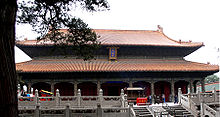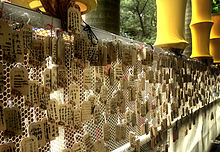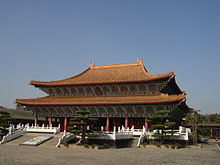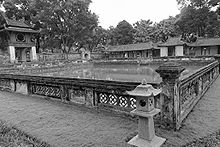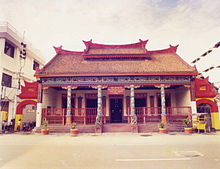- Temple of Confucius
-
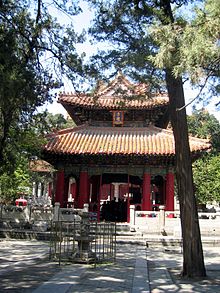 Apricot Platform in the Confucian Temple at Qufu.
Apricot Platform in the Confucian Temple at Qufu.
A Temple of Confucius or Confucian temple (simplified Chinese: 孔庙; traditional Chinese: 孔廟; pinyin: Kǒng miào) is a temple devoted to the memory of Confucius and the sages and philosophers of Confucianism.
Contents
History
The largest and oldest Temple of Confucius is found in Confucius's hometown, present-day Qufu in Shandong Province. It was established in 479 BC, one year after Confucius's death, at the order of the Duke Ai of the State of Lu, who commanded that the Confucian residence should be used to worship and offer sacrifice to Confucius. The temple was expanded repeatedly over a period of more than 2,000 years until it became the huge complex currently standing.
The development of state temples devoted to the cult of Confucius was an outcome of his gradual canonisation. In 195 BC, Han Gao Zu, founder of the Han Dynasty (r. 206–195 BC), offered a sacrifice to the spirit of Confucius at his tomb in Qufu. Sacrifices to the spirit of Confucius and that of Yan Hui, his most prominent disciple, began in the Imperial University (Biyong) as early as 241.
In 454, the first state Confucian temple was built by the Liu Song dynasty of south China (420 to 479). In 489, the Northern Wei constructed a Confucian temple in the capital, the first outside of Qufu in the north. In 630, the Tang Dynasty decreed that schools in all provinces and counties should have a Confucian temple, as a result of which temples spread throughout China. Well-known Confucian shrines include the Confucian Temple in Jianshui, the Confucian Temple in Xi'an (now the Forest of Steles), the Fuzi Miao in Nanjing, and the Confucian Temple in Beijing, first built in 1302.
In addition to Confucian temples associated with the state cult of Confucius, there were also ancestral temples belonging to the Kong lineage, buildings commemorating Confucius's deeds throughout China, and private temples within academies.
Structure
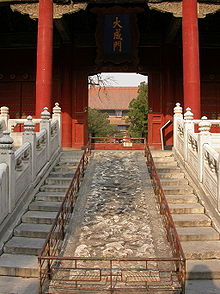 The Dachengmen inside the Confucius Temple in Beijing
The Dachengmen inside the Confucius Temple in Beijing
Beginning in the Tang dynasty (618-907), Confucian temples were built in prefectural and county schools throughout the empire, either to the front of or on one side of the school.[1] The front gate of the temple is called the Lingxing Gate (simplified Chinese: 棂星门; traditional Chinese: 欞星門). Inside there are normally three courtyards, although sometimes there are only two. However, the complex in Qufu has nine courtyards containing scores of steles commemorating visits by an emperor or imperial grants of noble titles upon descendants of Confucius. The main building, situated in the inner courtyard with entry via the Dachengmen (simplified Chinese: 大成门; traditional Chinese: 大成門), is called the Dachengdian (Chinese: 大成殿), variously translated as "Hall of Great Achievement", "Hall of Great Completion", or "Hall of Great Perfection". In imperial China, this hall housed the Spirit Tablets (Chinese: 神位) of Confucius and those of other important sages (simplified Chinese: 圣; traditional Chinese: 聖) and worthies (simplified Chinese: 贤; traditional Chinese: 賢). In front of the Dachengdian in Qufu is the Apricot Pavilion or Xingtan (simplified Chinese: 杏坛; traditional Chinese: 杏壇). Another important building behind the main building is the Shrine of Adoring the Sage (Chongshengci simplified Chinese: 崇圣祠; traditional Chinese: 崇聖祠), which honoured the ancestors of Confucius and the fathers of the Four Correlates and Twelve Philosophers.
Unlike Daoist or Buddhist temples, Confucian temples do not normally have images. In the early years of the temple in Qufu, it appears that the spirits of Confucius and his disciples were represented with wall paintings and clay or wooden statues. Official temples also contained images of Confucius himself. However, there was opposition to this practice, which was seen as imitative of Buddhist temples.[2] It was also argued that the point of the imperial temples was to honour Confucius's teachings, not the man himself.
The lack of unity in likenesses in statues of Confucius first led Emperor Taizu of the Ming dynasty to decree that all new Confucian temples should contain only spirit tablets and no images. In 1530, it was decided that all existing images of Confucius should be replaced with spirit tablets in imperial temples in the capital and other bureaucratic locations, a rule still followed today. However, statues remained in temples operated by Confucius's family descendants, such as that in Qufu.
Worship
The state cult of Confucius centred upon offering sacrifices to Confucius's spirit in the Confucian temple.
A dance known as the Eight-Row Dance, consisting of eight columns of eight dancers each, was also performed. Originally this was a Six-Row Dance, as performed for the lesser aristocracy, but in 1477 Confucius was allowed the imperial honour of the eight-row dance since he posthumously received the title of king.
In addition to worshipping Confucius, Confucian temples also honoured the "Four Correlates" (四配), the "Twelve Philosophers" (十二哲), and other disciples and Confucian scholars through history. The composition and number of figures worshipped changed and grew through time. Since temples were a statement of Confucian orthodoxy, the issue of which Confucians to enshrine was a controversial one.
By the Republican period (20th century), there were a total of 162 figures worshipped. The Four Correlates include Yan Hui, Zeng Shen, Kong Ji, and Mencius. The Twelve Philosophers are Min Zijian, Ran Boniu, Zhong Gong, Cai Wo, Zi-gong, Ran You, Zi-Lu, Zi-You, Zi-Xia, Zi-Zhang, You Ruo, and Zhu Xi. A list of disciples of Confucius and their place in the Confucian temple can be found at Disciples of Confucius.
Confucian temples outside mainland China
With the spread of Confucian learning throughout East Asia, Confucian temples were also built in Vietnam, Korea, and Japan. Starting in the 18th century, some were even built in Europe and the Americas. At their height, there are estimated to have been over 3,000 Confucian temples in existence.
Taiwan
The first Confucian Temple in Taiwan was the "Taiwan Confucian Temple" (台灣孔廟), which was built in the period of Tungning Kingdom (1661–1683). A more recent one, the Taipei Confucius Temple (臺北市孔廟), was begun on Wenwu Street in Taipei in 1879, torn down by Japanese in 1907, to make place for the Taipei First Girls' High School, and reerected on Dalong Street from 1925 to 1939. The new temple was designed by Wang Yi-Shun, who also oversaws its construction. The design is an example for typical Fujian temple style. Every year on September the 28th, the birthday of Confucius, city authorities hold here the Shidian Ceremony. In addition, there is a Confucian temple located in Zuoying District Kaohsiung that was completed in 1974 in the Northern Song architectural style.
Vietnam
A Confucian Temple in Vietnam is called Văn Miếu. The earliest recorded Confucian Temple in Vietnam is the Temple of Literature or Van Mieu in Hanoi, established in 1070. After 1397, with the construction of schools throughout Vietnam under the Tran, Confucian temples began to spread throughout the country. Well known Confucian temples were built in Hue, Hoi An, Hung Yen, Hai Duong, and Bac Ninh.
Korea
Outside China, the largest number of Confucian temples is found in Korea. Temples were first built during the Goryeo period (918-1392). In the time of Yi Seonggye (r. 1392-1398), it was decreed that Confucian temples should be built in all areas of the nation. Although Chinese models were followed, variations in layout and construction were common, such as the building of schools in front of temples. Korea also added its own scholars (the eighteen scholars of the East) to the Confucian pantheon.
Historically, Korea had a total of 362 temples devoted to the cult of Confucius. After World War II and the division of the country, those in the North were converted to other uses. However, many of the 232 temples in the South continued their activities (see Munmyo). In addition to temples devoted to the cult of Confucius, the Republic of Korea also has twelve Confucian family temples, two temples in private schools, and three libraries.
Japan
Confucian temples (孔子廟 kōshi-byō) were also widely built in Japan, often in conjunction with Confucian schools. The most famous is the Yushima Seido, built in 1630 during the Edo period as a private school connected with the Neo-Confucianist scholar Hayashi Razan. Originally built in Shinobi-ga-oka in Ueno, it was later moved to Yushima (Ochanomizu) by the Tokugawa Shogunate and reopened as a school of Confucianism to spread the teachings of the Hayashi school.
Other well known Confucian temples are found in Nagasaki, Bizen (Okayama prefecture), Taku (Saga prefecture), and Naha (Okinawa prefecture).
Indonesia
Confucian temples are also found in Indonesia, where they are often known as "Churches of Confucius" as Confucianism is a recognised religion in that country. In Chinese, these establishments are known as litang (礼堂) or "halls of worship". The largest and oldest is the Boen Bio in Surabaya, originally built in the city's Chinatown in 1883 and moved to a new site in 1907. There are reportedly more than 100 Confucianist halls of worship throughout Indonesia.
Malaysia
The first Confucian temple in Malaysia was built within a primary school known as Chung Hwa Confucian School (which has since split into SJK(C) Chung Hwa Confucian A, B and SMJK Chung Hwa Confucian) in Penang, in the early 20th Century. The building of the school was initiated by the Qing dynasty ambassador to the British Straits Settlement at that time. In those days parents in Penang brought their children to this temple for prayer before they began their schooling. The children prayed for excellence in their studies.
There is also 2 Confucian schools in Kuala Lumpur, namely SMJK Confucian and Confucian Private School, and a Confucian school in Malacca where ceremonies in honour of Confucius are held annually.
Alternate names
In Chinese, Confucian temples are known as Kong Miao (lit. The Temple of Confucius simplified Chinese: 孔庙; traditional Chinese: 孔廟; pinyin: Kǒng miào). Alternative names are:
- 文庙/文廟 (pinyin: wén miào) literally "Culture temple" or "Temple of literature"
- 圣庙/聖廟 (pinyin: shèng miào) literally "Sacred temple" or "Sage temple"
- 夫子/夫子廟 (pinyin: fū zi miào) literally "Master temple", derived from the full Chinese name of Confucius (孔夫子)
Names in other countries of Asia are based on the Chinese names. For example:
- Korean: 孔子廟 (공자묘 Kongja myo), 文廟 (문묘 Munmyo)
- Japanese: 孔子廟 (Kōshi-byō), 聖廟 (Sei-byō)
- Vietnamese: Văn miếu (Chinese 文廟), Văn thánh miếu (Chinese 文聖廟)
- Indonesian: Boen Bio (Chinese 文廟)
Temples
- The Confucian Temple at Qufu
- Beijing Confucian Temple
- Shanghai Wen Miao
- Văn Miếu of Hanoi
- Van Mieu Xich Dang, Vietnam
- Munmyo of Korea
- Yushima Seidō, Tokyo, Japan
- Taku Seibyō, Taku, Saga Prefecture, Japan
- Nagasaki Confucius Shrine, Nagasaki, Japan
- Taiwan Confucian Temple, Tainan
- Li Tang (hall of worship) in Indonesia
References
External links
- Images of the Temple of Culture, with detailed history of Confucian temples
- Full Virtual Walk & Info on Confucius Temple, Beijing
- Asian Historical Architecture: Fuzimiao in Nanjing
- Asian Historical Architecture: Confucian temple in Suzhou
- The Confucian temple in Tainan
- Surabaya, with description of Boen Bio
- The Taipei Confucius Temple
Shandong topics General Geography Cities • North China Plain • North China craton • Mount Tai • Shandong Peninsula • Yellow River • Hai He • Grand Canal of China • Weishan Lake • Laizhou Bay • Bohai Sea • Yellow SeaEducation Culture Cuisine Visitor attractions List of sites in Jinan • Baotu Spring • Daming Lake • Thousand Buddha Mountain • Lingyan Temple • Pizhi Pagoda • Great Wall of Qi • Penglai City • Qingdao beach resort city • Temple and Cemetery of Confucius • Shou QiuCategories:- 478 BC establishments
- Shrines
- Confucian temples
- Confucius
Wikimedia Foundation. 2010.

